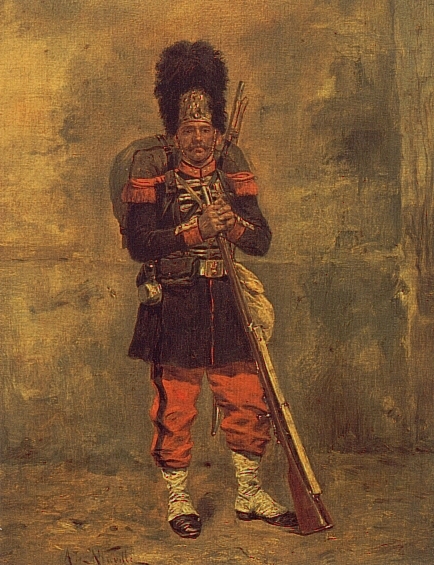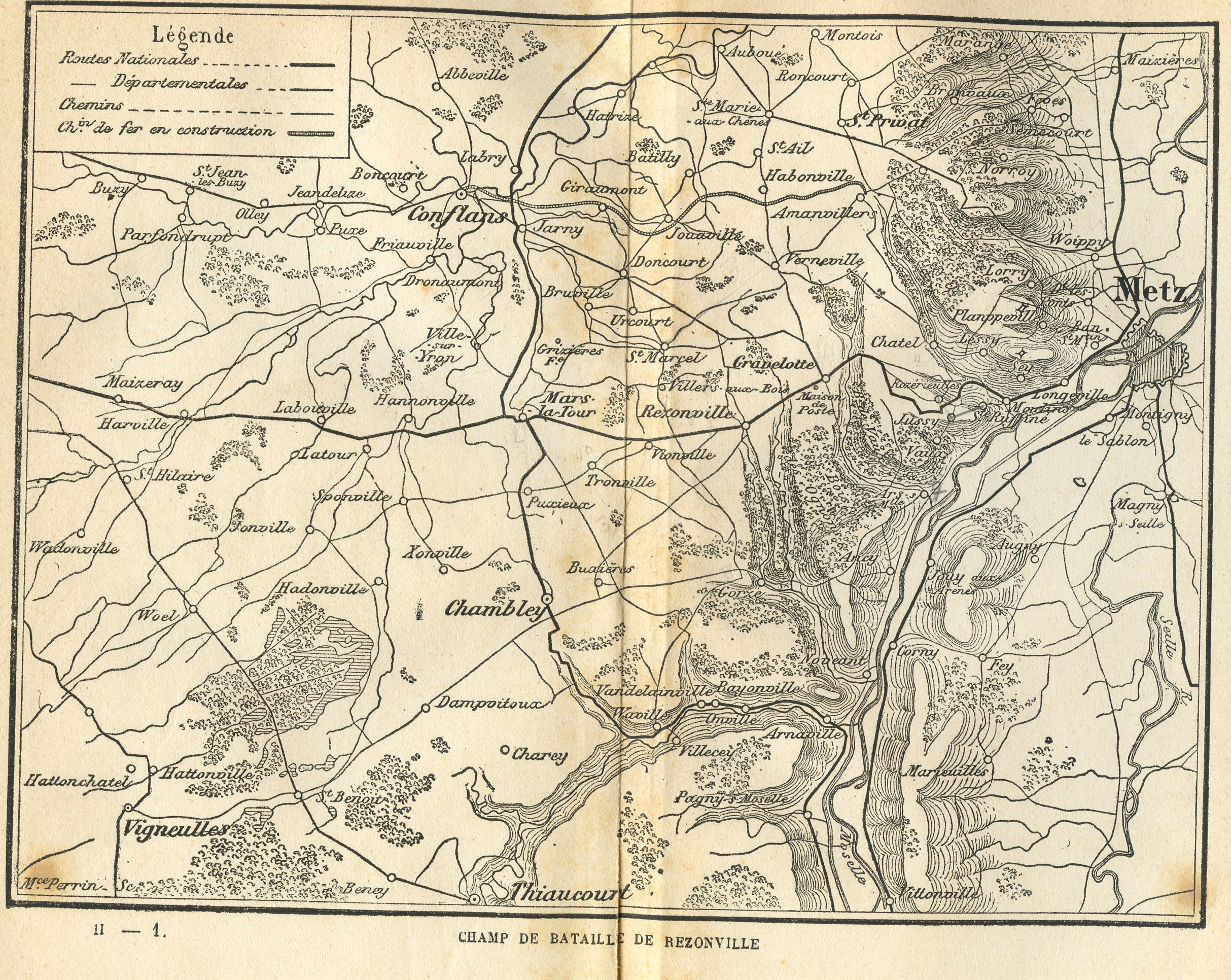|
Imperial Guard (Napoleon III)
The Imperial Guard of Napoleon III was a military corps in the French Army formed by Napoleon III as a re-establishment of his uncle Napoleon I's Imperial Guard, with an updated version of the original uniforms and almost the same privileges. Origin The Imperial Guard was formed by a decree of the emperor on 1 May 1854, and was made up of 17 regiments of cavalry, artillery and infantry, squadrons of train (supply and administration) and mounted gendarmes, and a division taken from the corps of military engineers. The emperor added a regiment of Zouaves to the Guard in 1855, selected from the three existing regiments of zouaves first raised in 1830. Divisional structure In its original 1854 structure the Imperial Guard comprised a mixed division of two infantry brigades (Grenadiers and Voltigeurs) plus one cavalry brigade of Cuirassiers and Guides. Additional units included two battalions of foot gendarmes, one battalion of Chasseurs a' pied, five batteries of Horse Artillery and ... [...More Info...] [...Related Items...] OR: [Wikipedia] [Google] [Baidu] |
Grenadier Second Empire - Alphonse De Neuville
A grenadier ( , ; derived from the word ''grenade'') was originally a specialist soldier who threw hand grenades in battle. The distinct combat function of the grenadier was established in the mid-17th century, when grenadiers were recruited from among the strongest and largest soldiers. By the 18th century, the grenadier dedicated to throwing hand grenades had become a less necessary specialist, yet in battle, the grenadiers were the physically robust soldiers who led assaults, such as storming fortifications in the course of siege warfare. Certain countries such as France (Grenadiers à Cheval de la Garde Impériale) and Argentina (Regiment of Mounted Grenadiers) established units of Horse Grenadiers and for a time the British Army had Horse Grenadier Guards. Like their infantry grenadier counterparts, these horse-mounted soldiers were chosen for their size and strength (heavy cavalry). Today, the term is also used to describe a soldier armed with a grenade launcher, a weapon t ... [...More Info...] [...Related Items...] OR: [Wikipedia] [Google] [Baidu] |
Train (military)
In military contexts, a train is the logistical transport elements accompanying a military force. Often called a supply train or baggage train, it has the job of providing materiel for their associated combat forces when in the field. When focused on provision of field artillery and its ammunition, it may be termed an artillery train. For sieges, the addition of siege engines to an artillery train was called a siege train. These military terms predate, and do not imply a railway train, though railways are often employed for modern logistics, and can include armoured trains. For armies, this historically usually referred to forces employing wagons, horses, mules, oxen, camels, or even elephants. These can still be useful where difficult weather or topography limit use of railways, trucks, sealift, or airlift. The United States Department of Defense ''Dictionary of Military and Associated Terms'' defined the term "train" as: History Antiquity In the Ancient Macedonian army, ... [...More Info...] [...Related Items...] OR: [Wikipedia] [Google] [Baidu] |
Bearskin
A bearskin is a tall fur cap, usually worn as part of a ceremonial military uniform. Traditionally, the bearskin was the headgear of grenadiers, and remains in use by grenadier and guards regiments in various armies. Bearskins should not be confused with other types of fur military headdresses, notably the smaller busby. History The cloth caps worn by the original grenadiers in European armies during the seventeenth century were frequently trimmed with fur. The practice fell into disuse until the second half of the eighteenth century, when grenadiers in the British, Spanish, and French armies began wearing high fur hats with cloth tops, and, sometimes, ornamental front plates. Imitating their Prussian counterparts, French grenadiers are described as wearing bearskins as early as 1761. The purpose appears to have been to add to the apparent height and impressive appearance of these troops both on the parade ground and the battlefield. During the nineteenth century, the e ... [...More Info...] [...Related Items...] OR: [Wikipedia] [Google] [Baidu] |
Charles Bourbaki
Charles is a masculine given name predominantly found in English and French speaking countries. It is from the French form ''Charles'' of the Proto-Germanic name (in runic alphabet) or ''*karilaz'' (in Latin alphabet), whose meaning was "free man". The Old English descendant of this word was '' Ċearl'' or ''Ċeorl'', as the name of King Cearl of Mercia, that disappeared after the Norman conquest of England. The name was notably borne by Charlemagne (Charles the Great), and was at the time Latinized as ''Karolus'' (as in ''Vita Karoli Magni''), later also as '' Carolus''. Some Germanic languages, for example Dutch and German, have retained the word in two separate senses. In the particular case of Dutch, ''Karel'' refers to the given name, whereas the noun ''kerel'' means "a bloke, fellow, man". Etymology The name's etymology is a Common Germanic noun ''*karilaz'' meaning "free man", which survives in English as churl (< Old English ''ċeorl''), which developed its depre ... [...More Info...] [...Related Items...] OR: [Wikipedia] [Google] [Baidu] |
Siege Of Metz (1870)
The siege of Metz was a battle fought during the Franco-Prussian War from August 19 to October 27, 1870 and ended in a decisive Allied German victory. The French Army of the Rhine under François Bazaine retreated into the Metz fortress after its defeat by the Germans at the Battle of Gravelotte on 18 August 1870. The fortress was promptly surrounded by German forces under Prince Friedrich Karl of Prussia. The French Army of Châlons was sent to relieve the Army of the Rhine but was itself encircled and annihilated by the German armies at the Battle of Sedan on 1–2 September. Unable to capture the fortress by bombardment or storm, the besieging Germans resorted to starving the French to submission. French attempts to break out ended in defeat at the battles of Noisseville on 31 August – 1 September and Bellevue on 7 October. French food supplies ran out on 20 October and François Achille Bazaine surrendered the fortress and the entire Army of the Rhine, some 193,000 ... [...More Info...] [...Related Items...] OR: [Wikipedia] [Google] [Baidu] |
Battle Of Gravelotte
The Battle of Gravelotte (or Battle of Gravelotte–St. Privat) on 18 August 1870 was the largest battle of the Franco-Prussian War. Named after Gravelotte, a village in Lorraine, it was fought about west of Metz, where on the previous day, having intercepted the French army's retreat to the west at the Battle of Mars-la-Tour, the Prussians were now closing in to complete the destruction of the French forces. The combined German forces under King Wilhelm I were the Prussian First and Second Armies of the North German Confederation with 210 infantry battalions, 133 cavalry squadrons, and 732 heavy cannons totaling 188,332 officers and men. The French Army of the Rhine, commanded by Marshal François Achille Bazaine, dug in along high ground with their southern left flank at the town of Rozerieulles, and their northern right flank at St. Privat. On 18 August, the Prussian First Army under General Karl Friedrich von Steinmetz launched its VII and VIII Corps in repeated assaults a ... [...More Info...] [...Related Items...] OR: [Wikipedia] [Google] [Baidu] |
Battle Of Mars-la-Tour
The Battle of Mars-la-Tour (also known as the Battle of Vionville or Battle of Rezonville) was fought on 16 August 1870, during the Franco-Prussian War, near the village of Mars-La-Tour in northeast France. One Prussian corps, reinforced by two more later in the day, encountered the entire French Army of the Rhine in a meeting engagement and, surprisingly, forced the Army of the Rhine to retreat toward the fortress of Metz. A cavalry patrol of the 1st Squadron of the 1st Hanoverian Dragoon Regiment No. 9, led by Rittmeister Oskar von Blumenthal, discovered that Marshal François Bazaine's 160,000-man Army of the Rhine was attempting to escape from Metz to join with French forces at Verdun. This intelligence prompted General Prince Friedrich Karl, commander of the Prussian Second Army, to order at 1900 on 15 August a grossly outnumbered group of 30,000 men of the advanced III Corps under General Constantin von Alvensleben to cut off the French line of retreat at Mars-la-Tour ... [...More Info...] [...Related Items...] OR: [Wikipedia] [Google] [Baidu] |
Mexican Expedition
The Pancho Villa Expedition—now known officially in the United States as the Mexican Expedition, but originally referred to as the "Punitive Expedition, U.S. Army"—was a military operation conducted by the United States Army against the paramilitary forces of Mexican revolutionary Pancho Villa, Francisco "Pancho" Villa from March 14, 1916, to February 7, 1917, during the Mexican Revolution of 1910–1920. The expedition was launched in retaliation for Villa's Battle of Columbus (1916), attack on the town of Columbus, New Mexico, and was the most remembered event of the Border War (1910–19), Mexican Border War. The declared objective of the expedition by the Woodrow Wilson, Wilson administration was the capture of Villa.Yockelson, Mitchell"The United States Armed Forces and the Mexican Punitive Expedition: Part 1" ''Prologue Magazine'', Fall 1997, Vol. 29, No. 3. Retrieved 5 Mar 2015 Despite locating and defeating the main body of Villa's command who were responsible for ... [...More Info...] [...Related Items...] OR: [Wikipedia] [Google] [Baidu] |
Second Italian War Of Independence
The Second Italian War of Independence, also called the Franco-Austrian War, the Austro-Sardinian War or Italian War of 1859 ( it, Seconda guerra d'indipendenza italiana; french: Campagne d'Italie), was fought by the Second French Empire and the Savoyard Kingdom of Sardinia against the Austrian Empire in 1859 and played a crucial part in the process of Italian Unification. A year prior to the war, in the Plombières Agreement, France agreed to support Sardinia's efforts to expel Austria from Italy in return for territorial compensation in the form of the Duchy of Savoy and the County of Nice. The two states signed a military alliance in January 1859. Sardinia mobilised its army on 9 March 1859, and Austria mobilized on 9 April. On 23 April, Austria delivered an ultimatum to Sardinia demanding its demobilization. Upon Sardinia's refusal, the war began on 26 April. Austria invaded Sardinia three days later, and France declared war on Austria on 3 May. The Austrian invasion wa ... [...More Info...] [...Related Items...] OR: [Wikipedia] [Google] [Baidu] |
Crimean War
The Crimean War, , was fought from October 1853 to February 1856 between Russia and an ultimately victorious alliance of the Ottoman Empire, France, the United Kingdom and Piedmont-Sardinia. Geopolitical causes of the war included the decline of the Ottoman Empire, the expansion of the Russian Empire in the preceding Russo-Turkish Wars, and the British and French preference to preserve the Ottoman Empire to maintain the balance of power in the Concert of Europe. The flashpoint was a disagreement over the rights of Christian minorities in Palestine, then part of the Ottoman Empire, with the French promoting the rights of Roman Catholics, and Russia promoting those of the Eastern Orthodox Church. The churches worked out their differences with the Ottomans and came to an agreement, but both the French Emperor Napoleon III and the Russian Tsar Nicholas I refused to back down. Nicholas issued an ultimatum that demanded the Orthodox subjects of the Ottoman Empire be placed ... [...More Info...] [...Related Items...] OR: [Wikipedia] [Google] [Baidu] |


.jpg)
.jpg)




